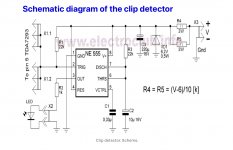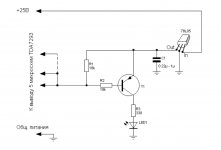+1Any single ended Class A preamp will be.
I will recommend to build Pocket Class A amp by X as a preamp.
The PCA makes an excellent sounding pre, and the pcb is very small too, so you can fit it in the TDA7293 enclosure to make an integrated amp maybe.
Bare PCBs for Pocket Class A Headphone Amplifier / Desktop / | Etsy
For clean power you can use this:
Simple Cap Mx Regulated Power Supply | Etsy
I will prefer to get pair of Lithium Ion rechargeable battery with charger. It reduces the time of building the project. Once charged I can listen for a week.
Any suggestions on a good pre I could use with this amp?
My suggestion is to consider how much, if any, additional gain is required in the overall system context. It's quite possible that you don't need a preamp at all - maybe something like a DCB1, or even a simple passive attenuator, will be quite sufficient.
Last edited:
Sometimes a 0dB gain buffer with volume pot can work really well too. Examples include Pass B1 Buffer. Although these use hard to find 2SK170 JFETs, although substitutes with LSK170 can also be used.
Many commercial pro sound booth headphone monitor amps work as preamps too.
Like these:
Rolls PM50s Personal Monitor Amplifier , Black https://www.amazon.com/dp/B00J14G7OO/ref=cm_sw_r_cp_api_glt_fabc_04JRFW9EW5QNKX7VV4AT
Behringer Microamp HA400 Ultra-Compact 4-Channel Stereo Headphone Amplifier,Silver https://www.amazon.com/dp/B000KIPT30/ref=cm_sw_r_cp_api_glt_fabc_YXBASASV2CDJQYPM08CR
Donner Headphone Amplifier DC 5V-1A, 3.5mm Rechargeable Portable Headphone amp Using 8Ω-250Ω Impedance, with 2 XLR and 1/4” TRS Input Portable in-Ear Monitor Amp https://www.amazon.com/dp/B08D8Y8J2H/ref=cm_sw_r_cp_api_glt_fabc_EV2H9M137R78Q6B567MB
The above use opamps - and they are the perfect use case for an opamp.
Many commercial pro sound booth headphone monitor amps work as preamps too.
Like these:
Rolls PM50s Personal Monitor Amplifier , Black https://www.amazon.com/dp/B00J14G7OO/ref=cm_sw_r_cp_api_glt_fabc_04JRFW9EW5QNKX7VV4AT
Behringer Microamp HA400 Ultra-Compact 4-Channel Stereo Headphone Amplifier,Silver https://www.amazon.com/dp/B000KIPT30/ref=cm_sw_r_cp_api_glt_fabc_YXBASASV2CDJQYPM08CR
Donner Headphone Amplifier DC 5V-1A, 3.5mm Rechargeable Portable Headphone amp Using 8Ω-250Ω Impedance, with 2 XLR and 1/4” TRS Input Portable in-Ear Monitor Amp https://www.amazon.com/dp/B08D8Y8J2H/ref=cm_sw_r_cp_api_glt_fabc_EV2H9M137R78Q6B567MB
The above use opamps - and they are the perfect use case for an opamp.
Last edited:
I concur about using the Elnas at C5&11. They take a bit to settle in but they do pleasantly change the sonics. Smoother, possibly a bit airier but that’s subjective. Bass response isn’t affected as far as I can hear. I don’t really crank up the music so I can’t confirm what happens to the overall response & attack with only 320uF per side when the system is pushed. It’s too bad all the big cap PCB positions weren’t made with slightly bigger mounting diameters.
Dibya....did you ever try replacing C6&9 with Silmics as well? Ever try caps other than FCs to drive the signal or is ESR important here?
Regards, Pete
I never did , Changes made by PSU caps are very subtle though i personally prefer Panasonic FR Series. I used to love Elna Cerafine but i think they are no more available.
Sometimes a 0dB gain buffer with volume pot can work really well too. Examples include Pass B1 Buffer. Although these use hard to find 2SK170 JFETs, although substitutes with LSK170 can also be used.
Probably a bit niche, but I'll be driving my Xmas amp with a 0dB gain buffer, in my case using even harder to obtain vintage BUF03 devices;
Aunt Corey's Homemade Buffered Passive Preamplifier | Stereophile.com
They work really well with amazingly good sound quality and are very simple to implement. The BUF03 can drive headphones too.
A Buffered Headphone Driver. – HeadWize Memorial
My buffer will use a Muses-based volume control.
I never did , Changes made by PSU caps are very subtle though i personally prefer Panasonic FR Series. I used to love Elna Cerafine but i think they are no more available.
Thanks Dibya...
Pete
Probably a bit niche, but I'll be driving my Xmas amp with a 0dB gain buffer, in my case using even harder to obtain vintage BUF03 devices;
Aunt Corey's Homemade Buffered Passive Preamplifier | Stereophile.com
They work really well with amazingly good sound quality and are very simple to implement. The BUF03 can drive headphones too.
A Buffered Headphone Driver. – HeadWize Memorial
My buffer will use a Muses-based volume control.
Sorry, what was all that Elvis stuff about? Reminds me of the MOFO thread.
Instead of a $25 BUF03, try a $4 OPA1656. They are quite nice and can also drive headphones. Two of the OPA1656 chips in parallel gives 4x parallel channels and can drive 1W into 32ohm cans with very low distortion. I have a headphone amp that uses exactly this setup.
But even one OPA1656 can drive 100mA which is plenty for many headphones.
Instead of a $25 BUF03, try a $4 OPA1656.
Why would I spend $8 on two OPA1656s when I already have six BUF-03s available? As I said, it's a bit niche but they sound excellent so I'll make use of them - I was just reporting my project direction in the context of a buffer being appropriate if you don't need the additional gain of a preamp.
If you have them already, of course no need. Just giving you and others options in case you want to try making a buffer or preamp.
hi,
Is the tda7294v a suitable drop in for the 7293?
thanks
in this pcb , no as we are using bootstrap pin.
If you have them already, of course no need. Just giving you and others options in case you want to try making a buffer or preamp.
Sorry I was perhaps a bit curt X, I've been having a stressful few days and let it show.
Hi NB,
No worries - hope all is well. We all can use some stress relief in these times. Audio is a great way to relax.
Cheers,
X
No worries - hope all is well. We all can use some stress relief in these times. Audio is a great way to relax.
Cheers,
X
Thanks X. Yeah, getting to a better place now - I had a bit of a health scare but it looks like it's all checking out OK.
I just noticed that there is a clip detector on the TDA7293. I can’t believe it took so many posts for people to figure out how it works? From what I gather, it’s just an LED and say 10k resistor to positive supply and the TDA7293 clip provide open collector logic?
Schematic for TDA7293 clip detector?
Schematic for TDA7293 clip detector?
I just noticed that there is a clip detector on the TDA7293. I can’t believe it took so many posts for people to figure out how it works? From what I gather, it’s just an LED and say 10k resistor to positive supply and the TDA7293 clip provide open collector logic?
Schematic for TDA7293 clip detector?
Here’s a link to a clip detector circuit designed by a gentleman named Audiokiller. You might need to have your browser do a Russian to English translation if you go to the other links on the page. It seems you can use one circuit and have up to 6 TDA7293s (pin 5) attached to it.
Клип-детектор для TDA7293 - AudioKiller's site
Cheers,
Pete
Attachments
Last edited:
Thanks Pete. Seems pretty complicated - I was hoping a simple LED would do, but maybe this is to give it some sort of hysteresis to make it easier to see.
Thanks Pete. Seems pretty complicated - I was hoping a simple LED would do, but maybe this is to give it some sort of hysteresis to make it easier to see.
X, Audiokiller made the point that the simple circuit (that you first showed) will work but unless it’s a long session of clipping it may not light the LED for long enough to even visualize the clip (assuming one even uses a really bright LED). Add to that, as he claims, the circuit inside the TDA7293 that controls pin 5 is not high speed. The attached diagram is the most minimal circuit he thought would work keeping a 5 volt & 0.5 mA "rule" as he termed it.
This is his story and may not not invalidate your thoughts on the implementation.
Pete
Attachments
Hi,
may I ask a side question regarding the chip?
Mind to have a look at the ST datasheet's page 13? As the definitions of class G and H amplifiers don't appear to be consistent, what do the darlingtons in this circuit do really? Do they switch the upper rails, or do they modulate it? At page 11 the datasheet says they're switching, but is this trustworthy, as I don't recognize a Schmitt trigger or any other hard switching section?
Best regards!
may I ask a side question regarding the chip?
Mind to have a look at the ST datasheet's page 13? As the definitions of class G and H amplifiers don't appear to be consistent, what do the darlingtons in this circuit do really? Do they switch the upper rails, or do they modulate it? At page 11 the datasheet says they're switching, but is this trustworthy, as I don't recognize a Schmitt trigger or any other hard switching section?
Best regards!
- Home
- Amplifiers
- Chip Amps
- Xmas Amp - Dibya's TDA7293 by Jhofland

